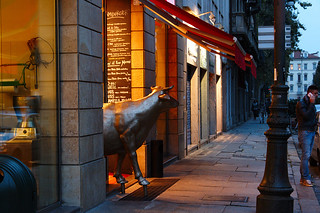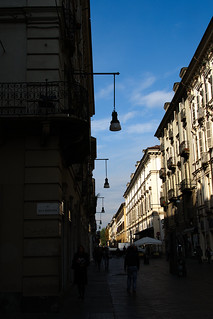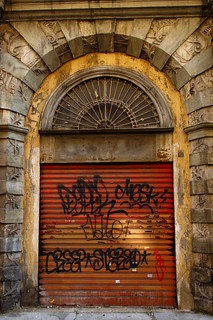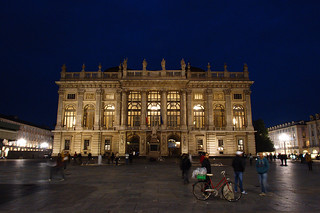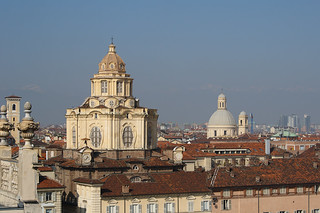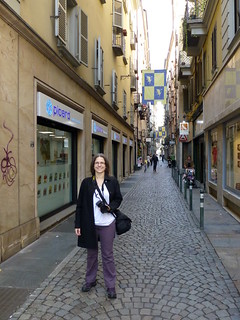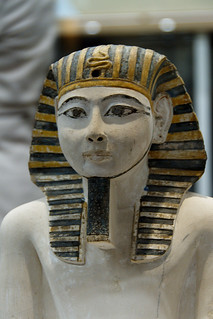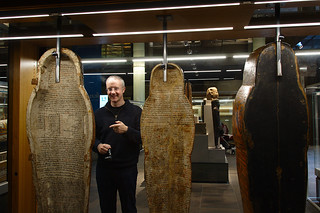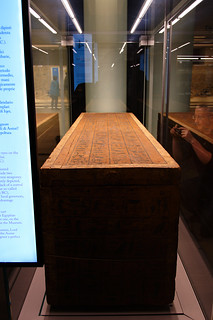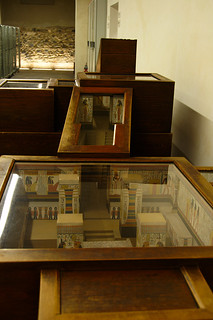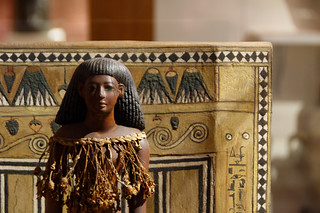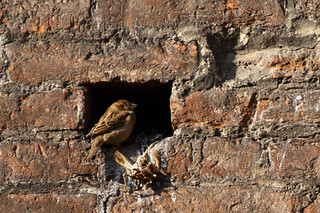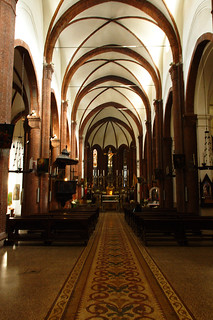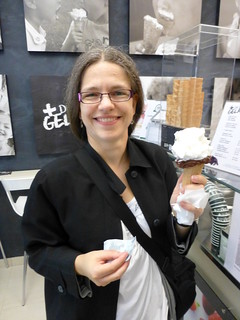The second episode of Alastair Sooke’s series about the art of Ancient Egypt covered the Middle Kingdom (briefly) and most of the New Kingdom. He only picked a couple of objects from the Middle Kingdom – both from Senusret III’s reign. He gave the impression that this is because the New Kingdom was the Golden Age, which is true in some ways, but the Egyptians themselves looked back at the Middle Kingdom as their “classical age” where art and culture first achieved great heights. I think it’s a shame he didn’t make it more clear the reason it gets short-shrift in programmes like these is because not as much survives for one reason or another. Often because sites were re-used or updated by New Kingdom Egyptians wanting the association with past glories.
The other eight treasures on the programme were from the New Kingdom between the reigns of Hatshepsut and Tutankhamun. As well as looking at some of the iconic art from her reign he spent some time talking about the iconography of Hatshepsut as Pharaoh. Pharaohs are male, so Hatshepsut was represented with all the male accoutrements and a masculine body in her official art works. One thing I hadn’t realised before (or had forgotten) is that it was during Hatshepsut’s time that the term Pharaoh actually started to be used – it translates to “the palace” so it’s the equivalent of talking about the White House doing X or Y in the USA (and surprisingly the example Sooke used was Brits talking about the Crown which I don’t even think is the best of the possible UK equivalents – No. 10 would be better).
There was obviously some considerable discussion of the new art style that Akhenaten brought with him when he changed the state religion. Both in terms of the slightly bizarre body shapes of the earliest stuff, and the new informal poses and domestic scenes on official art works. Which does give a very different impression of the royal family of that time, even as I remind myself it’s propaganda first & foremost. Obviously the bust of Nefertiti featured in this section, you can’t really miss it out. But the item from around that era (just before it) that struck me most was the little glass fish, that’s now in Berlin. I’ve seen it before & it’s a lovely piece, but what made it the highlight of this programme for me was that they showed us how it was made. I’ve read about how these glass objects were made before but it’s different actually watching it happen. And as always I’m somewhat in awe of what people were able to do before the advent of modern technology.
Obviously the programme ended with Tutankhamun’s mask – another iconic piece you can’t miss out, which also illustrates how what we have to admire depends so much on chance. The next episode covers the rest of Egyptian culture up to Cleopatra, quite a wide range. There’ve been a few clips of the temple at Abu Simbel, so presumably that’ll feature 🙂
This week we finished watching Dominic Sandbrook’s series about the Cold War – Strange Days: Cold War Britain. This three part series looked at British history from 1946 through to 1989 through the lens of how the Cold War affected politics and culture. So part of the series was Sandbrook telling us about the major events of the Cold War, and giving some indication what life was like on the other side, to give us context for the effects on Britain. And the other part was looking at events in Britain from a perspective we don’t always think of. Some stuff was obvious when you thought about it – like the popularity of James Bond films tying in to revelations about Russian spies in the UK. And the John le Carré novel The Spy Who Came in from the Cold as the much less glamorous and more cynical take on the same thing. Other things less so – consumerism being a part of how we differentiated “us” from “them” makes sense when I think about it, but I’d never’ve thought of how capitalism was in some ways kept in check by a desire to prove it was better than the alternatives. Which made more sense when Sandbrook talked about it than I have quite managed to articulate here!
The threat of nuclear war and how that shaped our culture was one of the strands running through the programmes, and the various attempts government made to prepare people for this. Sandbrook highlighted several times the contrast between the almost optimistic government handbooks which aimed not to panic people (even if this backfired at times) and the bleak films and TV serieses which were closer to what the reality might be. He showed us clips from The War Game (a 60s film that wasn’t shown on TV for about 20 years) which was a meticulously researched documentary, and Threads (an 80s film) which was more overtly fictional. Both grim enough even in excerpt that I know I don’t want to watch them in full. In the third programme Sandbrook also mentioned a book he’d read for class when he was 10 (I looked him up on wikipedia, he’s a couple of months younger than me) – as he started to talk about it I knew exactly which book he meant before the reveal. It was “Brother in the Land” by Robert Swindells, which I’ve read. Once. I’ve dipped into it occasionally since, and it’s still on my shelves, because I remember it as a good, well written book. But I’ve never re-read it cover to cover, despite my love of post-apocalypic novels. It’s just an extremely grim and depressing and unrelentingly bleak tale of the first months after a nuclear war. I read it at about 13 or 14, a few years after it was published, and it’s stuck with me since then – it must’ve been pretty traumatising to read at the age of 10 particularly when you had to think about it for school rather than stick your head in the sand (I’ve always adopted the ostrich approach to the idea of The End of the World As We Know It catastrophes).
Anyway, that was a bit of a digression. I liked this series, in particular I thought they did a good job of mixing archival footage with new stuff seamlessly switching between the two in a way that made the old stuff seem more immediately relevant. I even liked the somewhat overblown style, but I think J found the sweeping generalised claims made at times a little irritating.
We also finished another series this week – Rise of the Continents – which I really enjoyed so I wanted to say a few words about it even though this post is already quite long! This was a series about plate tectonics and the geological history of the earth, presented by Iain Stewart. Each week Stewart looked at a different continent (Africa, Australia, the Americas and Eurasia) and followed the geological story of the continent after it split from Pangea (the supercontinent that existed when the dinosaurs roamed the earth). He showed us the evidence that tells us about this geological story, and he also showed the impact that geology has had on both evolution and on human history. He’s a geologist so was strongest on that subject, pretty good on palaeontology but said a couple of dubious historical things we noticed (but otherwise was OK on that). Basically what you’d expect as he got further from his actual area of expertise. He was also a charmingly enthusiastic presenter.
One reason I enjoyed it so much is because I think the idea of plate tectonics is inherently cool. The earth not being static but consisting of vast sheets of crust all moving around and crashing into each other is awesome. It’s also an area I don’t know much about – I think the last time I read a book on it was in the 80s, when the science was still fairly new. So there were all sorts of things I didn’t know, and most of them were in the “neat facts” category. Like did you know that as India travelled on its way to crashing into Eurasia it moved over a magma plume, which turned a big chunk of it into a zone of volcanoes. This thinned the land so India started to move quicker. But also while it sat over this region for a few hundred thousand years the amount of volcanic eruption dumped toxins in the oceans and changed the climate – so this is thought to have contributed to the decline of the dinosaurs (before an asteroid finished them off). Or did you know the silver mines in South America exist because of subduction of the Pacific Ocean floor carries water down under the land. I can’t quite remember how Stewart said this then lead to the silver deposits, but the very idea of water being carried down under the crust is one I’d not thought of before (and it’s kinda cool as a concept).
I think J didn’t like the visual effects on the programme much – there were quite a few transitions where they used a jumble of still shots and mixed up audio before Stewart explained something. It didn’t bother me as much though.
Other TV watched this week:
Episode 2 of Sacred Wonders of Britain – Neil Oliver visits several sacred sites in Britain dating from prehistoric times through to the Reformation.
Episode 2 of The Brain: A Secret History – Michael Mosley series about brains, minds and experimental psychology. We never managed to record episode 1 but we decided to watch the other two anyway.
Episode 6 of Tudor Monastery Farm – part re-enactment, part documentary about what life would be like living on and running a farm in 1500.
